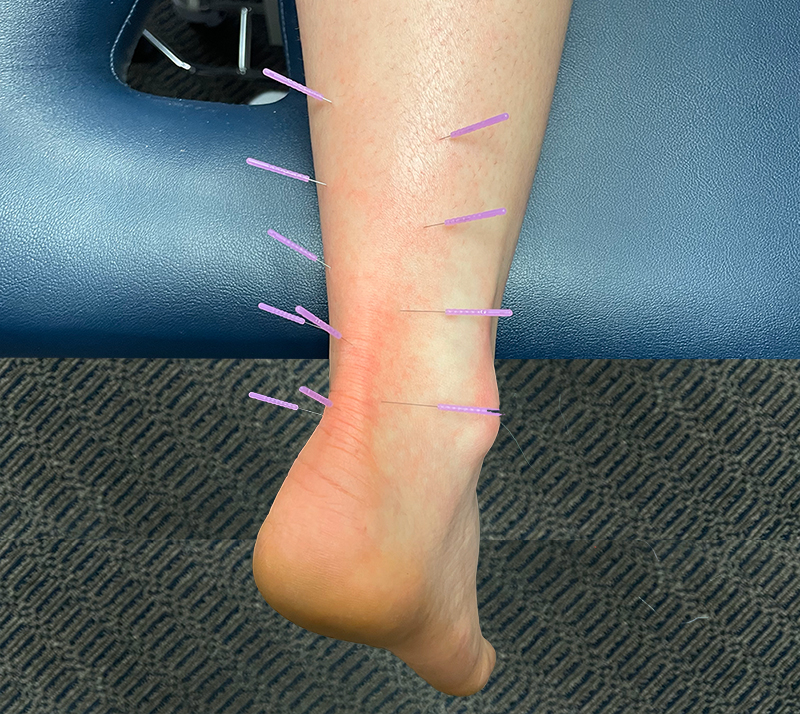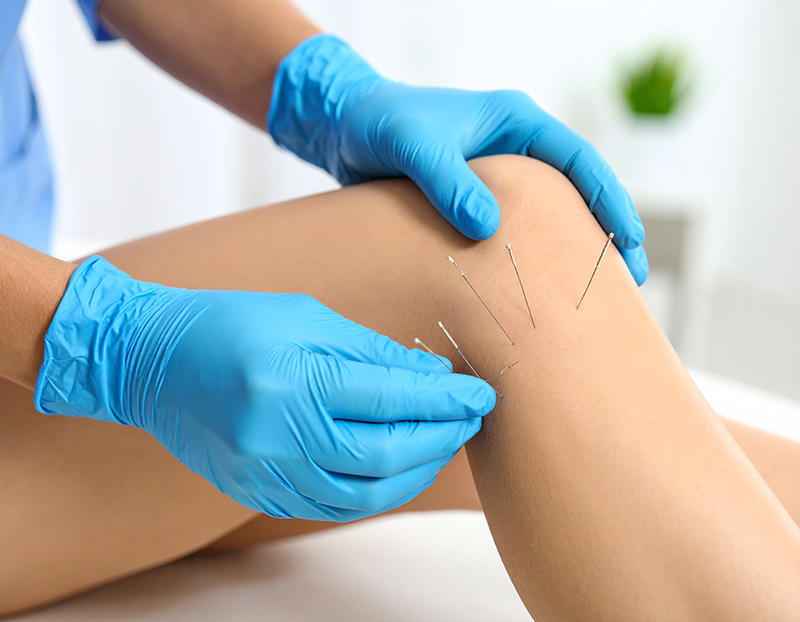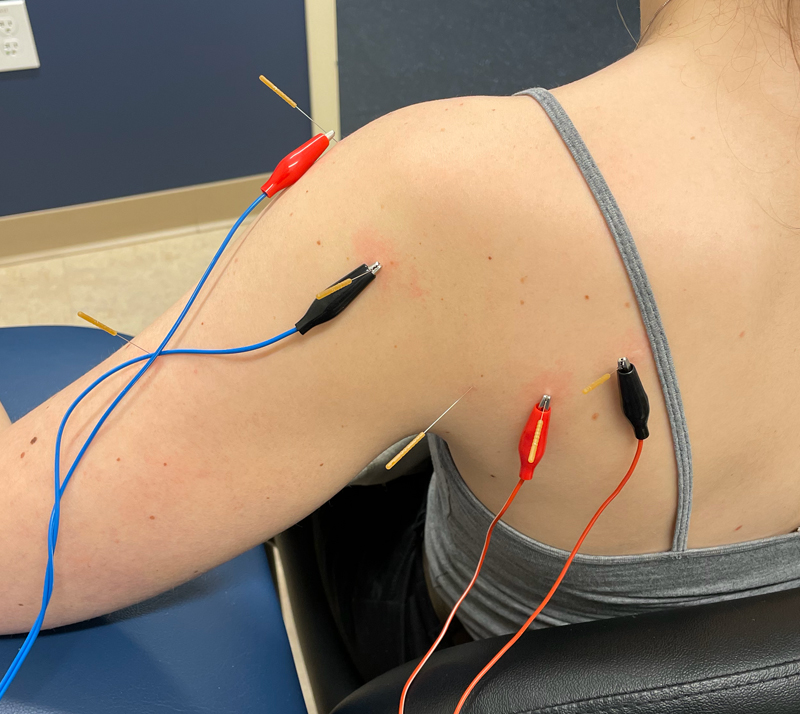What Is Dry Needling?
It’s a Safe Way to Relieve Pain and Improve Movement!
~ BY MATTHEW COELHO, DPT ~

At Atlantic Physical Therapy, we believe in using the most effective, evidence-informed treatments to help our patients feel and move better. One of the tools we use is dry needling, a modern, science-backed technique for managing pain, reducing muscle tightness, and improving movement patterns. Whether you’re recovering from an injury, managing chronic discomfort, or working to optimize your performance, dry needling can be a powerful part of your care.
What exactly is Dry Needling?
Dry needling is a technique where a physical therapist inserts thin, sterile, monofilament needles into specific muscle trigger points, those taut, sensitive knots you sometimes feel in sore or overworked muscles. These points can contribute to pain, limited range of motion, or dysfunctional movement patterns.
Despite looking similar to acupuncture needles, dry needling is not acupuncture. It’s based on Western anatomical and neurophysiological principles. The goal isn’t to affect “energy channels” but to address muscular and nervous system dysfunction at its source.1

How Does It Work?
When a needle is inserted into a trigger point, several things happen:
- It creates a local twitch response, helping the muscle relax.
- It disrupts dysfunctional nerve signaling.
- It increases blood flow to the area.
- It stimulates a healing response by triggering the body’s natural repair mechanisms.
At Atlantic Physical Therapy, we frequently combine dry needling with electrical stimulation (e-stim). Once the needles are inserted, they can be gently connected to an e-stim unit that delivers a mild electrical current. This promotes deeper muscle relaxation and further pain relief, especially useful for chronic or stubborn conditions.2

All of Our Therapists Are Certified in Dry Needling
You’re in good hands, every physical therapist at Atlantic Physical Therapy is certified in dry needling. Our training ensures safe, precise application and maximizes the benefits of this technique. We stay up to date on the latest clinical guidelines and continue to refine our techniques as the research evolves.
What does Dry Needling Help Treat?
Dry needling is used to treat a wide variety of musculoskeletal issues, especially those involving muscle tightness, overuse, or poor movement coordination. Common conditions we treat with dry needling include:3
- Neck pain and tension headaches
- Low back pain and sciatica
- Shoulder pain, rotator cuff injuries, and frozen shoulder
- Tennis elbow and golfer’s elbow
- Hip pain and IT band syndrome
- Gluteal tendinopathy and piriformis syndrome
- Knee pain and patellar tendinopathy
- Plantar fasciitis and Achilles tendinopathy
- Jaw pain (TMJ dysfunction)
- Post-surgical tightness or muscle guarding
Whether you’re an athlete, a weekend warrior, or managing chronic pain from everyday wear and tear, dry needling can help restore normal muscle function and reduce pain.
What Can I Expect During and After a Session?
During the session:
Your therapist will assess your movement and palpate the involved muscles. Once the target trigger points are identified, the therapist will insert very thin needles into the tissue. You may feel a brief twitch or mild ache during insertion. If e-stim is used, you’ll feel a gentle pulsing or tapping sensation at the site.
After the session:
Most patients feel some soreness for 24-48 hours, similar to post-exercise soreness. This usually fades quickly, and many patients report improved motion, decreased pain, and better function afterward.
We always combine dry needling with other proven interventions, such as corrective exercises, manual therapy, stretching, and patient education, to ensure lasting improvements.
Is Dry Needling Safe?
Yes—dry needling is a safe and well-tolerated technique when performed by certified professionals. All of our therapists use clean technique, sterile needles, and follow state and national practice standards. As with any treatment, we’ll screen for any contraindications and make sure dry needling is right for you.
Most side effects are minor, mild soreness, a small bruise, or temporary fatigue, but serious complications are extremely rare.4
FAQs About Dry Needling
Is it painful? You may feel a quick twitch or mild ache, but many people describe the sensation as unusual rather than painful. The relief afterward usually outweighs any momentary discomfort.
How many sessions will I need? This depends on the condition being treated, but many patients feel noticeable relief after just 1-3 sessions. Dry needling is usually integrated into your full plan of care.
Is it the same as acupuncture? No. Although the tools look similar, the training, purpose, and philosophy behind dry needling are different. Dry needling is based on Western medicine principles and targets specific muscle dysfunction.
Take the Next Step Toward Relief
If you’re struggling with pain, tightness, or limited mobility, and traditional treatments haven’t brought lasting relief, dry needling might be the solution you’ve been looking for!
Contact Atlantic Physical Therapy today to learn more or to schedule an appointment with one of our certified therapists. Let us help you move better, feel better, and get back to what matters most.
References:
- Dunning J, Butts R, Mourad F, Young I, Flannagan S, Perreault T. Dry needling: a literature review with implications for clinical practice guidelines. Phys Ther Rev. 2014 Aug;19(4):252-265. doi: 10.1179/108331913X13844245102034. PMID: 25143704; PMCID: PMC4117383.
- Gattie E, Cleland JA, Snodgrass S. The Effectiveness of Trigger Point Dry Needling for Musculoskeletal Conditions by Physical Therapists: A Systematic Review and Meta-analysis. J Orthop Sports Phys Ther. 2017 Mar;47(3):133-149. doi: 10.2519/jospt.2017.7096. Epub 2017 Feb 3. PMID: 28158962.
- Chys M, De Meulemeester K, De Greef I, Murillo C, Kindt W, Kouzouz Y, Lescroart B, Cagnie B. Clinical Effectiveness of Dry Needling in Patients with Musculoskeletal Pain-An Umbrella Review. J Clin Med. 2023 Feb 2;12(3):1205. doi: 10.3390/jcm12031205. PMID: 36769852; PMCID: PMC9917679.
- Boyce D, Wempe H, Campbell C, Fuehne S, Zylstra E, Smith G, Wingard C, Jones R. ADVERSE EVENTS ASSOCIATED WITH THERAPEUTIC DRY NEEDLING. Int J Sports Phys Ther. 2020 Feb;15(1):103-113. PMID: 32089962; PMCID: PMC7015026.

